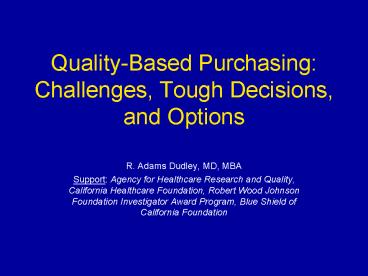QualityBased Purchasing: Challenges, Tough Decisions, and Options - PowerPoint PPT Presentation
1 / 23
Title:
QualityBased Purchasing: Challenges, Tough Decisions, and Options
Description:
Physicians: e.g., California Medical Association ... Are there agreed upon, non-proprietary data definitions and benchmarks? Even with NQF? ... – PowerPoint PPT presentation
Number of Views:24
Avg rating:3.0/5.0
Title: QualityBased Purchasing: Challenges, Tough Decisions, and Options
1
Quality-Based Purchasing Challenges, Tough
Decisions, and Options
- R. Adams Dudley, MD, MBA
- Support Agency for Healthcare Research and
Quality, California Healthcare Foundation, Robert
Wood Johnson Foundation Investigator Award
Program, Blue Shield of California Foundation
2
Outline of Talk
- A brief description of a real world example of
performance measurement - Addressing the tough decisions, with reference to
some solutions weve seen
3
CHART California Hospital Assessment and
Reporting Task Force
- A collaboration between California hospitals,
clinicians, patients, health plans, and
purchasers - Supported by the
- California HealthCare Foundation, Blue Shield of
California Foundation, and California hospitals
and health plans
4
Participants in CHART
- All the stakeholders
- Hospitals e.g., CHA, hospital systems,
individual hospitals - Physicians e.g., California Medical Association
- Consumers/Labor e.g., Consumers Union/California
Labor Federation - Employers e.g., PBGH, CalPERS
- Health Plans every plan with 3 market share
- Regulators e.g., JCAHO, OSHPD, NQF
- Government Programs CMS, MediCal
5
How CHART Might Play Out
6
Tough Decisions General Ideas and Our
Experience in CHART
- Not because weve done it correctly in CHART, but
just as a basis for discussion
7
Tough Decision 1Collaboration vs. Competition?
- Among health plans
- Among providers
- With legislators and regulators
8
Tough Decision 1Collaboration vs. Competition?
- Among health plans
- Among providers
- With legislators and regulators
9
Tough Decision 1AWho can collaborate?
- Easier to identify partners in urban areas
- Puget Sound Health Alliance is a good example of
a multi-stakeholder coalition - In rural areas?
- Consider medical societies for leadership, as
providers are often fragmented
10
Tough Decision 2Moving Beyond HEDIS/JCAHO
- No other measure sets routinely collected,
audited - If you want public reporting or P4P of new
measures, must balance data collection and
auditing costs vs. information gained - Admin data involves less data collection cost,
equal or more auditing costs - Chart abstraction much more expensive data
collection, equal or less auditing
11
Tough Decision 2Moving Beyond HEDIS/JCAHO
- If plans or a coalition drive the introduction of
new quality measurement costs, who pays and how? - Some approaches to P4P only reward the
winnersand many providers doubt theyll be
winners initially (or ever) - So, who picks the measures?
12
Tough Decision 3Same Incentives for Everyone?
- Does it make sense to set up incentive programs
that are the same for everyone? - This would be unusual in many other industries
- Providers differ in important ways
- Baseline performance/potential
- Preferred rewards (more patients vs. more )
- Monopolies and safety net providers
13
Tough Decision 3Same Incentives for Everyone?
- Monopolies? Weve seen situations in which
payers bristle at the idea of paying monopolists
more - What about providers that are already too busy?
14
Tough Decision 4Encourage Investment?
- Much of the difficulty we face in starting public
reporting or P4P comes from the lack of flexible
IT that can cheaply generate performance data. - Similarly, much QI is best achieved by creating
new team approaches to care. - Should we explicitly pay for these changes?
15
Tough Decision 5 Use Only National Measures or
Local?
- Well this is easy, national, right?
- Hmmm. Have you ever tried this? Is there any
there there? Are there agreed upon,
non-proprietary data definitions and benchmarks?
Even with NQF? - Maybe you should be leading NQF??
16
A Local Measure Developed in CHART
- Consumers wanted C-section rates
- Hospitals pointed out there is no accepted
appropriate or optimal C-section rate, and
that an overall rate should be risk-adjusted - Solution C-section rate for uncomplicated first
pregnancies (to give sense of tendency to do
C-section), without any quality label attached
17
Tough Decision 6Use Outcomes Data?
- Especially important issue as sample sizes get
small - If we cant fix the sample size issue, well be
forced to use general measures only (e.g.,
patient experience measures)
18
Outcome Reports
- Some providers are concerned about random events
causing variation in reported outcomes that
could - Ruin reputations (if there is public reporting)
- Cause financial harm (if direct financial
incentives are based on outcomes)
19
An Analysis of MI Outcomes and Hospital Grades
- From California hospital-level risk-adjusted
MI mortality data - Fairly consistent pattern over 8 years 10 of
hospitals labeled worse than expected, 10
better, 80 as expected - Processes of care for MI worse among those with
higher mortality, better among those with lower
mortality - From these data, calculate mortality rates for
worse, better, and as expected groups
20
(No Transcript)
21
3 Groups of Hospitals with Repeated Measurements
(3 Years)
22
Outcomes Reports and Random Variation Conclusions
- Random variation can have an important impact on
any single measurement - Repeating measures reduces the impact of chance
- Provider performance is more likely to align
along a spectrum rather than lumped into two
groups whose outcomes are quite similar - Providers on the superior end of the performance
spectrum will almost never be labeled poor
23
Conclusions
- Many tough decisions ahead
- Avoid paralysis or legislators and regulators
will lead - Consider collaboration on the choice of measures
- Everyone frustrated with JCAHO and HEDIS
measuresneed to figure out how to fund data
collection and auditing of new measures - Consider varying incentives across providers































